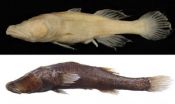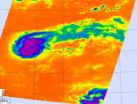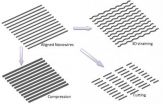(Press-News.org) A team of researchers from Louisiana State University and the American Museum of Natural History has discovered that two groups of blind cave fishes on opposite sides of the Indian Ocean are each other's closest relatives. Through comprehensive DNA analysis, the researchers determined that these eyeless fishes, one group from Madagascar and the other from similar subterranean habitats in Australia, descended from a common ancestor before being separated by continental drift nearly 100 million years ago. Their study, which appears in the journal PLOS ONE this week, also identifies new species that add to existing biological evidence for the existence of Gondwana, a prehistoric supercontinent that was part of Pangaea and contained all of today's southern continents.
"This is the first time that a taxonomically robust study has shown that blind cave vertebrates on either side of an ocean are each other's closest relatives," said Prosanta Chakrabarty, an assistant professor and curator of fishes at Louisiana State University's Museum of Natural Science. "This is a great example of biology informing geology. Often, that's how things work. These animals have no eyes and live in isolated freshwater caves, so it is highly unlikely they could have crossed oceans to inhabit new environments."
The cave fishes, of the genus Typhleotris in Madagascar and Milyeringa in Australia, are small—less than 100 millimeters long—and usually lack pigment, a substance that gives an organism its color and also provides protection from the sun's ultraviolet radiation. These characteristics, coupled with a lack of eyes and enhanced sensory capabilities, allow cave fishes to survive in complete darkness. For this reason, the fishes have very restricted distributions within isolated limestone caves. It's also why the newfound genetic relationship between the trans-oceanic groups is an exciting geological find.
"The sister-group relationship between cavefishes from Madagascar and Australia is a remarkable example of Gondwanan vicariance—a geographical split dating back to the Late Cretaceous some 100 million years ago," said John Sparks, a curator in the Division of Vertebrate Zoology at the American Museum of Natural History. "The interesting thing about Madagascar's extant freshwater fish groups, with the exception of a single species, is that all exhibit relationship patterns that are in time with the Mesozoic breakup of Gondwana—some are related to groups in India/Sri Lanka, and others to groups in Australia. Only a single freshwater species has its closest relative in nearby Africa."
One of the new species discovered by the researchers, which will be named in a future publication, is a novelty among cave fishes because it is fully and darkly pigmented. The analysis the researchers conducted for this fish's tree of life shows that it evolved from a pigment-free ancestor, indicating that some subterranean forms can "reverse" themselves for this character.
"It is generally thought that cave organisms are unable to evolve to live in other environments," Sparks said. "Our results, and the fact that we have recently discovered new cave fish species in both Madagascar and Australia belonging to these genera, are intriguing from another perspective: they show that caves are not so-called 'evolutionary dead ends.'"
Funding for the research expedition was provided by the Constantine S. Niarchos Expedition Fund, established by the Stavros Niarchos Foundation to support the research of museum curators around the globe. This particular expedition turned into more of an adventure than the group was planning—in fact, one of the new species has been given a moniker that means "big sickness" in Malagasy because of the dangers the team incurred while searching for specimens in this dry, inhospitable region of Madagascar.
"Only two specimens of the new pigmented form were recovered from the first cave we searched in Madagascar, despite the fact that we spent hours in this sinkhole," said Chakrabarty. "Even the locals hadn't been inside of it before."
Because remote locales with caving opportunities exist all over the world, the researchers are eager to pursue other opportunities for discovery.
"Conducting this research really developed my love for caving," said Chakrabarty. "You don't always find something exciting. But, when you consider how isolated many of these caves are, especially in places like Madagascar, and how unaffected they have been by the passage of time, you know that the fish in there are going to tell a really good story."
INFORMATION:
Matthew P. Davis, now a postdoctoral fellow at The Field Museum, also contributed to this research.
Research paper: http://dx.plos.org/10.1371/journal.pone.0044083
Eyeless Australian fish have closest relatives in Madagascar
Researchers are first to show ancient trans-oceanic relationship for vertebrate cave animals
2012-08-30
ELSE PRESS RELEASES FROM THIS DATE:
Heatwaves to move toward coasts, study finds
2012-08-30
A new study by researchers at Scripps Institution of Oceanography, UC San Diego, suggests that the nature of California heatwaves is changing due to global warming.
Climate researchers Alexander Gershunov and Kristen Guirguis detected a trend toward more humid heatwaves that are expressed very strongly in elevated nighttime temperatures, a trend consistent with climate change projections. Moreover, relative to local warming, the mid-summer heatwaves are getting stronger in generally cooler coastal areas. This carries implications for the millions of Californians living ...
Physics faculty try innovative teaching methods
2012-08-30
A study of physics faculty awareness and use of research-based instructional techniques offers greater understanding of what is missing from current education reform efforts
The world has changed dramatically in recent decades but many argue that the university system has not kept pace. As another academic year begins, if you peek into any introductory college science course you're likely to find the same scene as you would have twenty years ago: An instructor writing equations on the blackboard while a lecture hall full of students take notes.
Why is college science ...
Study shows hope of greater global food output, less environmental impact of agriculture
2012-08-30
MINNEAPOLIS / ST. PAUL (08/29/2012) —Can we have enough to eat and a healthy environment, too? Yes—if we're smart about it, suggests a study published in Nature this week by a team of researchers from the University of Minnesota and McGill University in Montreal.
Global demand for food is expected to double by 2050 due to population growth and increased standards of living. To meet this demand, it is often assumed we will need to expand the environmental burden of agriculture. The paper, based on analysis of agricultural data gathered from around the world, offers hope ...
Collagen-seeking synthetic protein could lead doctors to tumor locations
2012-08-30
Johns Hopkins researchers have created a synthetic protein that, when activated by ultraviolet light, can guide doctors to places within the body where cancer, arthritis and other serious medical disorders can be detected.
The technique could lead to a new type of diagnostic imaging technology and may someday serve as a way to move medications to parts of the body where signs of disease have been found. In a study published in the Aug. 27-31 Online Early Edition of Proceedings of the National Academy of Sciences, the researchers reported success in using the synthetic ...
Controlling gait of horses may be possible, says key study from Texas A&M
2012-08-30
COLLEGE STATION Aug. 29, 2012 – Analysis of a specific mutation in a gene in horses that affects the ability of horses to use alternate gaits is strongly related to racing performance and is advantageous for harness-racing horses. In domestic horses, the mutation has had a major impact on their diversification, as the altered gait characteristics of a number of breeds apparently require this mutation, according to a study that includes a Texas A&M University researcher.
Gus Cothran, a professor in the Animal Genetic Lab of the College of Veterinary Medicine & Biomedical ...
Tropical Storm Kirk looks more like a comet on NASA infrared imagery
2012-08-30
Tropical Storm Kirk looks more like a comet than a tropical storm in infrared imagery from NASA's Aqua satellite because of wind shear. NASA infrared imagery also revealed powerful thunderstorms around the center of circulation which are indicators that Kirk will continue strengthening. Meanwhile, another low pressure area appears to be organizing in the eastern Atlantic, far to the southeast of Kirk.
Tropical Depression Kirk formed from the eleventh tropical depression of the Atlantic Ocean season. Tropical Depression 11 formed on Aug. 28 at 5 p.m. EDT about 1,270 miles ...
NASA sees Hurricane Isaac make double landfall in Louisiana
2012-08-30
Hurricane Isaac made two landfalls in southeastern Louisiana. Isaac's first landfall occurred in southeastern Louisiana on Aug. 28 at 7:45 p.m. EDT (1145 UTC), second landfall on Aug. 29 at 6 a.m. EDT (1000 UTC). NASA's TRMM satellite observed heavy rainfall in this slow moving storm, which leads to higher rainfall totals and flooding.
NASA and NOAA satellites continue to provide detailed information to forecasters at the National Hurricane Center. Hurricane Isaac's first landfall occurred at 7:45 p.m. EDT in extreme southeastern Louisiana, bringing strong winds and dangerous ...
'Nano machine shop' shapes nanowires, ultrathin films
2012-08-30
WEST LAFAYETTE, Ind. –A new "nano machine shop" that shapes nanowires and ultrathin films could represent a future manufacturing method for tiny structures with potentially revolutionary properties.
The structures might be "tuned" for applications ranging from high-speed electronics to solar cells and also may have greater strength and unusual traits such as ultrahigh magnetism and "plasmonic resonance," which could lead to improved optics, computers and electronics.
The researchers used their technique to stamp nano- and microgears; form tiny circular shapes out of ...
When to worry about kids' temper tantrums
2012-08-30
CHICAGO --- Temper tantrums in young children can be an early signal of mental health problems, but how does a parent or pediatrician know when disruptive behavior is typical or a sign of a serious problem?
New Northwestern Medicine research will give parents and professionals a new tool to know when to worry about young children's misbehavior. Researchers have developed an easy-to-administer questionnaire specifically designed to distinguish the typical misbehavior of early childhood from more concerning misbehavior. This will enable early identification and treatment ...
Tracing the Paralympic movement's 'freak show' roots
2012-08-30
(Edmonton) Danielle Peers has lived the thrill and pressure, revelled in competition and brought home hardware from the Paralympic Games. But beneath the cheers, the University of Alberta researcher questions whether the Paralympic movement is as empowering as its benevolent image.
The former Paralympian bronze medallist and women's wheelchair basketball world champion says the history of the Paralympic movement dates to the freak shows of the 19th century—and even today's modern games are a spectacle of curiosity that reinforces disability.
"The Paralympics is one ...
LAST 30 PRESS RELEASES:
Insilico Medicine and Taigen achieves license agreement to develop and commercialize AI-driven PHD inhibitor for anemia of Chronic Kidney Disease (CKD)
Exploring dominant endophytic Pleosporales in grasses: New taxonomic insights in the suborder Massarineae
Comparative transcriptomic analysis of human maxillary and mandibular tooth germs reveals discrepancies in gene expression patterns
Scientists detect atmosphere on molten rocky exoplanet - study
Chip-scale magnetometer uses light for high-precision magnetic sensing
Illinois Tech biomedical engineering professor Philip R. Troyk elected as Fellow of the National Academy of Inventors
The National Academy of Inventors welcomes 2025 Class of Fellows
Multi-scale modelling framework predicts mechanical responses of Fe–Cr–Al alloys across composition and processing conditions
Preoperative radiation may improve antitumor immune response in most common form of breast cancer
Breast MRI may be safely omitted from diagnostic workup in certain patients with early-stage, HR-negative breast cancer
Sentinel lymph node biopsy may be safely omitted in some patients with early-stage breast cancer
Rats may seek cannabis to cope with stress
New FAU research strengthens evidence linking alcohol use to cancer
Gut health à la CAR T
Dr. Pengfei Liu receives 2026 O'Donnell Award in Medicine for pioneering advances in genetic diagnostics and rare disease treatment
Dr. Yunsun Nam receives 2026 O'Donnell Award in Biological Sciences for pioneering RNA research transforming gene regulation and cancer therapy
Dr. Bilal Akin wins 2026 O'Donnell Award in Engineering for transformative work in EV energy systems and industrial automation
Dr. Fan Zhang receives 2026 O'Donnell Award in Physical Sciences for groundbreaking discoveries in quantum matter and topological physics
Dr. Yue Hu receives 2026 O'Donnell Award for revolutionizing energy operations with real-time AI and reinforcement learning
Greater risk that the political right falls for conspiracy theories
JMC Publication: Insilico’s AI platforms enable discovery of potent, selective, oral DGKα inhibitor to overcome checkpoint resistance
Targeting collagen signaling boosts drug delivery in pancreatic cancer
Valvular heart disease is common in cancer patients but interventions improve survival
When socially responsible investing backfires
Cuffless blood pressure technologies in wearable devices show promise to transform care
AI-based tool predicts future cardiovascular events in patients with angina
Researchers map how the cerebellum builds its connections with the rest of the brain during early development
Routine scans could detect early prostate radiotherapy changes
Fairness in AI: Study shows central role of human decision-making
Pandemic ‘beneath the surface’ has been quietly wiping out sea urchins around the world
[Press-News.org] Eyeless Australian fish have closest relatives in MadagascarResearchers are first to show ancient trans-oceanic relationship for vertebrate cave animals




